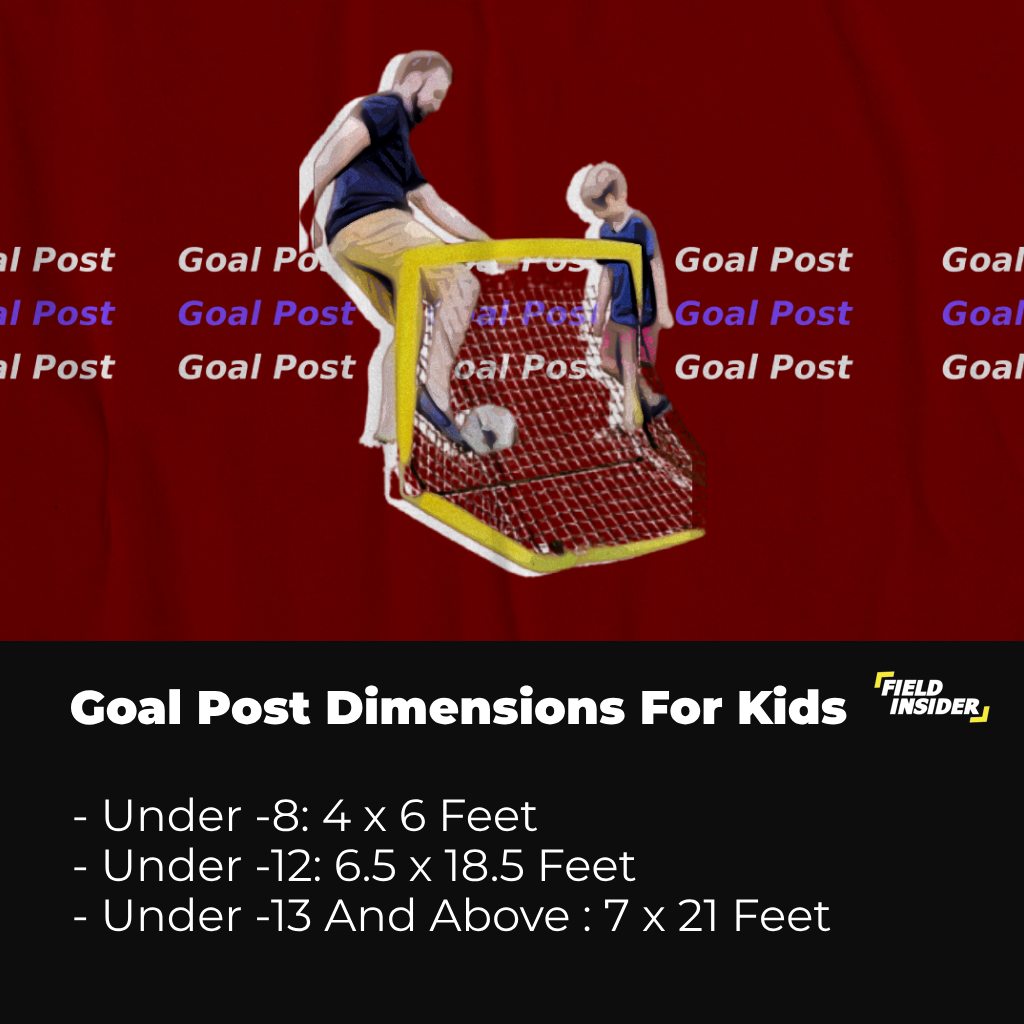Football Goal Post Dimensions: Youths & Adults
Soccer, a sport revered and played globally, hinges on several standardized elements to maintain its integrity and universal appeal. Among these, the dimensions of the goal posts are fundamental, directly impacting game strategy, player development, and the overall fairness of the match.
This article aims to shed light on the standardized dimensions of soccer goal posts for both youth and adult levels, highlighting their importance in fostering a safe, equitable, and enjoyable game for all participants.
Key Takeaway Table
| Aspect | For Youth | For Adult |
|---|---|---|
| Height | 6.5 – 7 feet | 8 feet |
| Width | 18 – 21 feet | 24 feet |
| Impact on Gameplay | Training focus | Professional play |
| Safety and Compliance | Age-appropriate | Regulation size |
| Skill Development | Basic techniques | Advanced tactics |
Understanding Goal Post Dimensions

Explanation of the Significance of Goal Post Dimensions in Soccer
The dimensions of goal posts are not arbitrary; they are fundamental to the structure and fairness of soccer. Correct goal sizes ensure that the game remains challenging yet accessible. It promotes a standardized environment where skills can be fairly compared and developed.
These dimensions are crucial for goalkeepers and outfield players alike, influencing the design of training programs and the development of player skills. They help maintain the global consistency of the sport, ensuring that a goal scored in one part of the world is judged by the same standards as a goal scored in another.
Clarification of the Differences Between Youth and Adult Goal Post Dimensions
| Aspect | Youth Dimensions | Adult Dimensions | Implications |
|---|---|---|---|
| Height | 6.5 – 7 feet | 8 feet | Youth dimensions are designed to be reachable for younger players, while adult dimensions pose a greater challenge and reflect the standard for professional play. |
| Width | 18 – 21 feet | 24 feet | The narrower width for youth goals aids in focusing on accuracy and technique, whereas the wider adult goals demand greater skill and provide a universal standard for gameplay. |
| Field Size | Smaller, varying sizes | Standardized | Youth fields and goals are scaled down to match player size and skill level, promoting development and enjoyment. Adult fields adhere to international standards to ensure uniformity in professional soccer. |
| Skill Development | Focus on basic skills and fun | Advanced techniques and strategies | Youth dimensions facilitate learning and development, allowing young players to improve fundamental skills. Adult dimensions challenge players to refine their skills and adapt to the professional level of play. |
| Regulatory Compliance | Varies by age group and league | FIFA and UEFA standards | Youth goals can differ based on local or regional regulations, promoting a tailored developmental approach. Adult goals must meet specific regulatory standards, ensuring fairness and consistency in official matches. |
Understanding these differences is crucial for coaches, players, and parents alike. For more on youth soccer’s structured approach, read about different levels in youth soccer.
Youth Soccer Goal Post Dimensions
Youth soccer goal post dimensions are specifically designed to cater to the varying sizes, skill levels, and developmental needs of younger players. These dimensions are scaled down compared to adult sizes. They provide a more suitable target for children. This aids in their soccer development.
Detailed Explanation of Standard Goal Post Dimensions for Youth Soccer
The standard dimensions for youth soccer goals vary depending on the age group. Typically, they range from 6.5 to 7 feet in height and 18 to 21 feet in width.
These smaller dimensions are intentionally set. They align with the physical capabilities of children. This makes the goals more attainable. It keeps the game enjoyable and rewarding.
Discussion on the Rationale Behind Youth-Specific Measurements
The rationale for youth-specific goal dimensions stems from a specific need. It is to provide a playing environment that is both challenging and achievable. Smaller goals ensure that young players can compete effectively, learn basic soccer skills, and develop confidence on the field.
This approach supports gradual learning. It ensures that as players grow and improve, they move up to larger goal sizes. This continues to challenge their developing skills.
Illustrative Examples of Age Groups and Corresponding Goal Post Dimensions

Different age groups in youth soccer typically use different goal sizes. For example:
- Under-6 to Under-8: Goals may range from 4 feet in height and 6 feet in width, focusing on fun and basic skills.
- Under-9 to Under-12: The goal size might increase to 6.5 feet in height and 18.5 feet in width, introducing players to a more structured game.
- Under-13 and above: Players might transition to goals that are 7 feet in height and 21 feet in width, preparing them for the full-sized game.
These tailored dimensions help facilitate a positive and educational experience. They allow young players to hone their skills and understand the game’s fundamentals. Then, they can progress to adult-sized goals.
Adult Soccer Goal Post Dimensions
In adult soccer, the goal post dimensions are standardized. This reflects the professional level of play and ensures uniformity across leagues and competitions worldwide.
These dimensions are designed to present an appropriate level of challenge for adult players and are used in all professional matches.
Examination of Standard Goal Post Dimensions for Adult Soccer
The standard dimensions for adult soccer goals are 8 feet in height and 24 feet in width. This size is used globally, from amateur leagues to the World Cup. It ensures that adult players face a consistent challenge, regardless of where they are playing.
These dimensions are critical for goalkeepers’ training and outfield players’ shooting accuracy, influencing tactics and gameplay at the highest levels.
Explanation of How Adult Dimensions Differ from Youth Measurements
Adult soccer goal dimensions are larger than those used in youth soccer to match the advanced physical and technical capabilities of adult players. The increased size demands greater accuracy and power in shooting and crosses.
This provides a realistic challenge that reflects an adult player’s skill level. This transition from youth to adult dimensions signifies a player’s progression in the sport. It adapts to the broader strategic and physical demands of the adult game.
Consideration of Various Leagues and Organizations’ Regulations on Goal Post Dimensions
While the standard dimensions are widely adopted, some adult leagues and organizations may implement additional specifications. These are to accommodate different levels of play or field conditions.
However, these variations are generally minimal, ensuring that all players prepare for and compete under conditions that closely mirror the global standards set by governing bodies like FIFA and UEFA.
These uniform dimensions in adult soccer help maintain the sport’s integrity and fairness. They also facilitate the transition of players from youth to adult soccer. This marks a significant step in their development and understanding of the game.
FA Recommended Soccer Goal Dimensions by Age Group
The bar chart presents a clear comparison of the recommended soccer goal post dimensions set by the Football Association (FA) for different age groups. It highlights the transition in goal size from youth categories to adult levels, underscoring the FA’s commitment to age-appropriate play.

For the U13-U14 group, the goal width stands at 21 feet, distinctly narrower than the 24 feet width prescribed for the older age categories. This distinction is crucial, as it reflects tailored developmental needs, allowing younger players to engage with dimensions that are challenging yet attainable.
As players advance to the U15-U16 and U17-U18 categories, and eventually to the adult category, the goal dimensions uniformly expand to a standard width of 24 feet and a height of 8 feet. This increase mirrors the physical and skill growth of players, presenting a consistent challenge that aligns with their evolving capabilities.
The chart effectively visualizes these changes, providing a straightforward reference for coaches, players, and parents to understand the standardized environment in which the game is played at various developmental stages.
Impact on Gameplay and Safety
The dimensions of soccer goal posts significantly influence the gameplay and safety aspects of the sport. Properly sized goals are essential for fair competition, skill development, and injury prevention.
Analysis of How Goal Post Dimensions Affect Gameplay Dynamics
The size of the goal post directly impacts the style and dynamics of the game. In youth soccer, smaller goals lead to more focused training on technique and accuracy. Larger adult-sized goals demand broader strategic thinking and physicality.
For instance, goalkeepers must adapt their techniques and positioning based on the goal size to effectively defend their net, influencing overall team tactics and individual player roles, such as those outlined in defensive and attacking formations.
Discussion on Safety Implications Associated with Properly Sized Goal Posts
Safety is a paramount concern in soccer, and the dimensions of goal posts play a critical role in ensuring player safety. Smaller, appropriately sized goals for youth soccer reduce the risk of injury by matching the physical capabilities of younger players.
Designers make standard-sized goals for adults to withstand the force of powerful shots. They prevent tipping or collapsing, which could lead to serious injuries. Understanding and implementing the correct goal sizes help in minimizing risks, as emphasized on preventing injuries for your kids.
Insights into How Goal Post Dimensions Contribute to Fair Play and Skill Development
Correct goal dimensions contribute to the principles of fair play and equitable competition. By adhering to standardized sizes, players can compete on a level playing field. Skill, teamwork, and strategy determine success rather than discrepancies in equipment or facilities.

Moreover, suitable goal sizes for different age groups and levels allow players to progressively develop their skills. This happens in an environment that matches their development stage, as seen in structured approaches like teamwork in youth soccer.
Ensuring that goal post dimensions meet the required standards is crucial. It maintains the integrity of the game, promotes safety, and supports the balanced development of all players.
Compliance and Regulations
Adhering to the standardized dimensions for soccer goal posts is not just a matter of fairness. It is also a regulatory requirement in official competitions. These regulations ensure that the game remains true to its universal standards, promoting an equal playing field for all participants.
Overview of Regulatory Bodies Responsible for Establishing Goal Post Standards
Various organizations, including FIFA, UEFA, and national soccer associations, are responsible for setting and enforcing the standard dimensions for soccer goal posts.
These bodies ensure that the sport maintains consistent rules and equipment standards, essential for international play and competition integrity.
Importance of Adhering to Established Dimensions for Official Matches
Compliance with standardized goal post dimensions is crucial for teams and facilities hosting official matches. Failure to meet these standards can result in penalties, disqualification, or other sanctions, undermining the fairness and outcome of competitions.
This emphasizes the necessity for clubs and organizations to regularly inspect and maintain their equipment to meet regulatory standards.
Consequences of Non-Compliance with Goal Post Regulations
Non-compliance with established goal post dimensions can lead to significant consequences. These range from the annulment of game results to financial penalties and loss of reputation.
It jeopardizes player safety and undermines the sport’s integrity. This highlights the importance of adherence to these regulations for all involved in the sport. Enforcement is guided by the rules found in football rules.
Conclusion
In conclusion, the standardized dimensions of soccer goal posts play a pivotal role in maintaining the integrity, fairness, and safety of the sport across all levels. By adhering to these established measurements, players, coaches, and officials can ensure a consistent, equitable, and enjoyable experience for everyone involved.
Understanding the specific dimensions for youth and adult soccer aids in the proper development and challenge of players. It also upholds the universal standards that make soccer the beloved global sport it is today.











